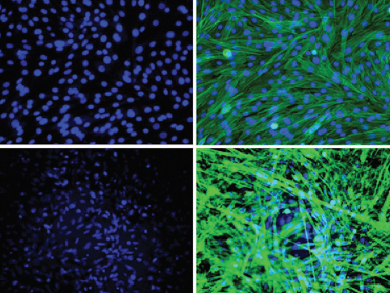Muscle fibers generally form by the fusion of parallel-aligned young muscle cells, so-called myoblasts, into multi-nucleated fibers. Myoblasts respond to electric stimuli and electricity can be used to direct their alignment. Thus, electrically active and conducting scaffolds are of special interest for muscle tissue engineering. Synthetic conducting polymers, such as polyaniline and polypyrrole, have been applied successfully, but they are limited in use due to insufficient biocompatibility, resulting in oxidative stress and cell death.
T. Govindaraju, Jawaharlal Nehru Centre for Advanced Scientific Research, Bangalore, India, and colleagues used silk fibroin as a scaffold for skeletal muscle tissue engineering (SMTE). Silk fibroin had already been used in biomedical tissue engineering due to its superior biocompatibility. To get a conducting material, the team incorporated melanin, which is a naturally occurring heterocyclic pigment consisting of repeating units of 5,6-dihydroxyindole and 5,6-dihydroxyindole-2-carboxylic acid. The researchers fabricated fiber mats from the composite material using electrospinning and tested them as scaffolds for growing myoblasts.
The composite of silk fibroin and melanin supports the differentiation of myoblasts into aligned muscle fibers. Furthermore, the scaffold shows strong antioxidant properties, leading to a reduction of oxidative stress and, hence, of cell death.
- Pigmented Silk Nanofibrous Composite for Skeletal Muscle Tissue Engineering,
Shivaprasad Manchineella, Greeshma Thrivikraman, Khadija K. Khanum, Praveen C. Ramamurthy, Bikramjit Basu, T. Govindaraju,
Adv. Healthcare Mater. 2016.
DOI: 10.1002/adhm.201501066




